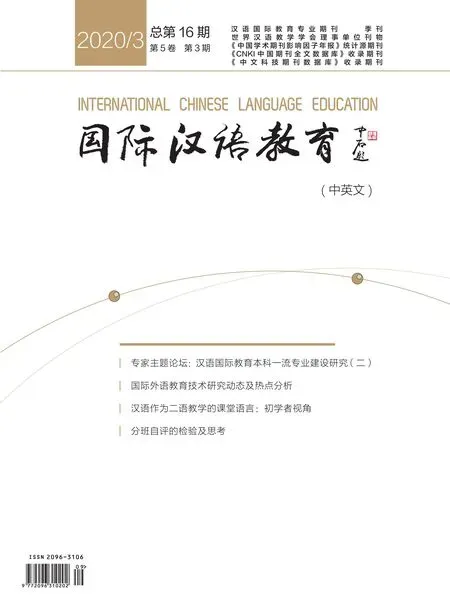Learning in a Project-based Classroom:The Effect of Technology
Liang Xin Center for Language Education, School of Humanities and Social Science, Hong Kong University of Science and Technology
Martha Lam Center for Language Education, School of Humanities and Social Science, Hong Kong University of Science and Technology
Abstract In order to cater to the varied learning needs of students with very different language abilities and cultural backgrounds, the researchers have adopted a Project-based Language Learning(PBLL) approach since 2014 in the teaching of an advanced Chinese communication course for non-Chinese speakers. It is believed that the PBLL course creates purposeful opportunities for language input and output, highlights specific features for language learning, as well as enhances student motivation, and collaborative and autonomous learning (Stoller, 2006). In 2016, the researchers investigated the effectiveness of the PBLL course, and concluded that the abovementioned benefits of PBLL would be optimized if the time and space constraints imposed by a strictly face-to-face delivery could be eased through blended online teaching (Liang & Lam,2017).Between 2017 and 2018, a Web-based Learning Platform (WeLP) which incorporated the concepts of Technology-enhanced Language Learning (TELL) and PBLL was constructed for the advanced Chinese communication course for non-Chinese speakers. The purpose-built webbased learning platform offers six distinctive functions: E-book, Reading Corner, Writing Corner,Speaking Corner, Chinese Pop-up Dictionary, and Self-learning Corner. Apart from introducing the design of the revised curriculum and the learning platform, this study seeks to investigate if the above-mentioned benefits of PBLL can be optimized when TELL is incorporated into the curriculum design and implementation. Surveys, focus group interviews and document analysis have been used in this research. The findings of the present study suggest that students of diverse backgrounds and learning needs can benefit greatly from a PBLL curriculum which is supported by a TELL platform.
Key words Technology-enhanced Language Learning; Project-based Language Learning; Teaching Chinese as a Foreign Language; effect of technology
I. Background
Currently, the Center for Language Education of the Hong Kong University of Science and Technology offers eight levels of Chinese communication courses(Chinese for Non-Chinese Language Background Students LANG1120-1127) to cater to the diverse needs and proficiency levels of students of non-Chinese speaking backgrounds. LANG1127, being the highest-level course, admits all students whose proficiency levels are beyond the benchmarked level of LANG1126. Hence, a typical LANG1127 class consists of students from a wide range of language abilities and cultural backgrounds. To cater to the varied learning needs and diverse proficiency levels of the students,from February 2014 onwards, the course has adopted a Project-based Language Learning (PBLL) approach because “it creates purposeful opportunities for language input, language output, and explicit attention to language-related features (e.g. forms, vocabulary,skills, strategies)” (Stoller, 2006). Kemaloglu (2010)states that PBLL is a self-directed approach to language learning, with an emphasis on the process and the product constructed by the students in collaboration with the instructor to achieve linguistic and nonlinguistic goals. Du (2012) also points out that PBLL is a constructive, individualized and meaning-seeking process. As such, the approach is well-suited for a class like LANG1127 with varied learning needs and diverse proficiency levels.
Compared to a traditional classroom, this constructivist and inquiry method of learning allows both the instructor and students flexibility in the choice of project topics, reading materials, communicative tasks and learning outcomes. The main elements of the course design were adapted from the AAU-PBL Model (the Aalborg University Model), the Task-based PBL model (Du, 2012) and the research conducted by Beckett and Slater (2005) which highlighted four important stages of the PBL model: Firstly, a group of students decide on a topic; secondly, group members create their project proposal and set their learning goals; thirdly, they conduct the project; and finally, they reflect on their learning journey.
The LANG1127 advanced Chinese communication course adopted a PBLL approach, and it offered three learning cycles. In the first learning cycle, students formed groups of 3 to 4 and collaboratively decided on the project topic and language learning objectives.They brainstormed possible areas of interest for their research, discussed how the project could be carried out, and presented their project proposal in class which outlined their initial thoughts on the choice of the research topic and data collection methods.The second cycle was packed with actions as students began their journey of inquiry and co-construction inside and outside class. Each group member took on a well-defined role and was encouraged to contribute to the project based on their interest, learning goals and strengths. In the third cycle, students’ learning focus shifted from the exploratory process to the coconstructed product as they prepared to conclude their work and to report their research findings in groups at the end of the 13-week semester. Individually, students went through a reflective process and wrote a study reflection about their learning journey.
Throughout the three cycles, teachers provided input on how to write a research paper and guidance on student needs, facilitated discussions and provided timely feedback in class. Figure 1 summarizes the three learning cycles of the advanced Chinese communication course (LANG1127).
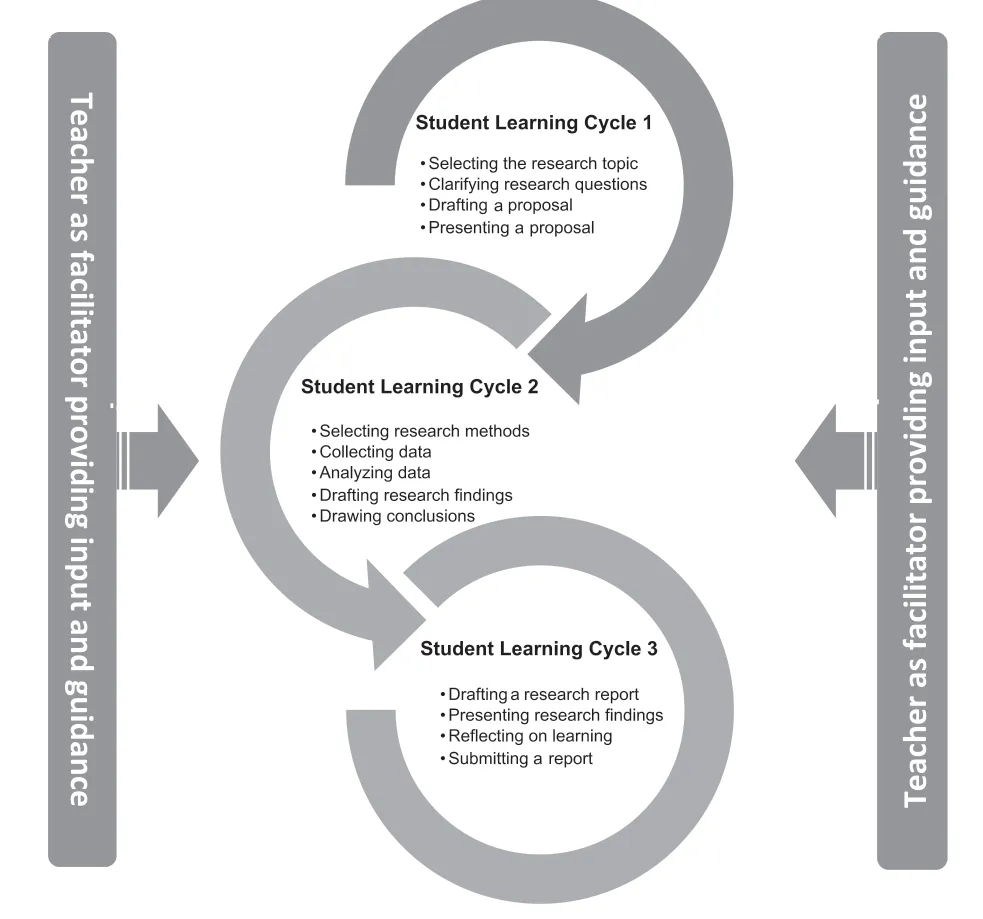
Figure 1 Three Learning Cycles of PBLL
A study which followed 3 cohorts of LANG1127 students in Fall 2014, Fall 2015 and Spring 2016 revealed that students welcomed the PBLL approach,and they reported that their Chinese competence had been raised, particularly in writing and in oral presentations. Seven features of the Project-based Language Learning were found to have promoted the acquisition of the Chinese competence (Liang & Lam,2017). While the study confirmed the effectiveness of the approach, it also indicated that the effectiveness of the PBLL approach had been compromised by the time and space constraints imposed by a strictly face-to-face delivery (Liang & Lam, 2017).
In the initial PBLL course design, students worked in groups in class, and they also spent a lot of time working on their own as well as collaborating with their group members outside class time. Hence, creating an environment conducive to language learning was essential for students’ self-directed learning,particularly in the provision of accessible resources and timely feedback. To sustain motivation, students needed a record of their out-of-class work so that they could see progress, and the class teacher could review progress and provide support and scaffolding of relevant learning experiences out of class. In brief, both the class teacher and students saw the need for some form of out-of-class guidance and monitoring.
In the attempt to further improve students’ learning experience, the authors went for the development of a web-based learning platform which would enable the incorporation of Technology-enhanced Language Learning (TELL) materials to the highestlevel Chinese Communication course, LANG1127.We believed that the addition of TELL would enhance the conditions for language learning to take place(Walker & White, 2013) and further increase the intensity of students’ motivation, and collaborative and autonomous learning (Stoller, 2006). Research showed that technology enabled quick feedback when assessing learners’ performance (Gohl, et al., 2009), and could facilitate collaboration and self-learning (Kelm, 2011;Lee, 2011; Jin, 2012). Sidman-Taveau and Milner-Bolotin (2001) also found that PBL with the assistance of the Internet benefited L2 learners. In 2018, a webbased learning platform (WeLP) was built with the Teaching Development Grant funding, and the course was redeveloped by using an integrated PBLL and TELL approach which allowed students access to more engaging materials and resources anytime in a webbased environment.
II. WeLP
The WeLP is intended to motivate and enable students to learn independently and showcase their work. It offers six distinctive featured components: E-book,Reading Corner, Writing Corner, Speaking Corner,Chinese Pop-up Dictionary, and Self-learning Corner. All the features are customized to enhance students’ autonomous learning, collaborative learning and student-teacher communication. Unlike its previous paper-version textbook, the E-book adapts and converts the original teaching materials to an interactive digital format. Audios and videos are embedded in the online texts, real-time explanations of vocabulary are added, on-line language practices are built-in and automatic checking of online exercises is enabled to ensure easy access to self-directed learning materials. The Reading Corner houses selected articles for supplementary reading and it allows students to upload and share research articles within their own project group and across groups. The Writing Corner also allows students to upload multiple drafts and to provide/receive peer and instructor feedback.Similarly, the Speaking Corner allows students to upload presentation in audio and video formats and to provide/receive peer and instructor feedback. The inclusion of the Chinese Pop-up Dictionary aims to encourage students to develop the habit of looking up new words while reading, as well as to build their own vocabulary collection. The Self-learning Corner caters to the diverse needs of a mixed-ability group. It provides a place where students can review vocabulary,learning points and “issues” discussed in class. A typical practice is that in class, the instructor takes photographs of all the supplementary teaching notes,such as new/difficult words/phrases/expressions/concepts/sentence structures, etc., on the whiteboard,and then turns the content into learning materials for students’ revision outside class. Figure 2 illustrates how WeLP supports the in-class teaching and the out-ofclass self-directed learning.
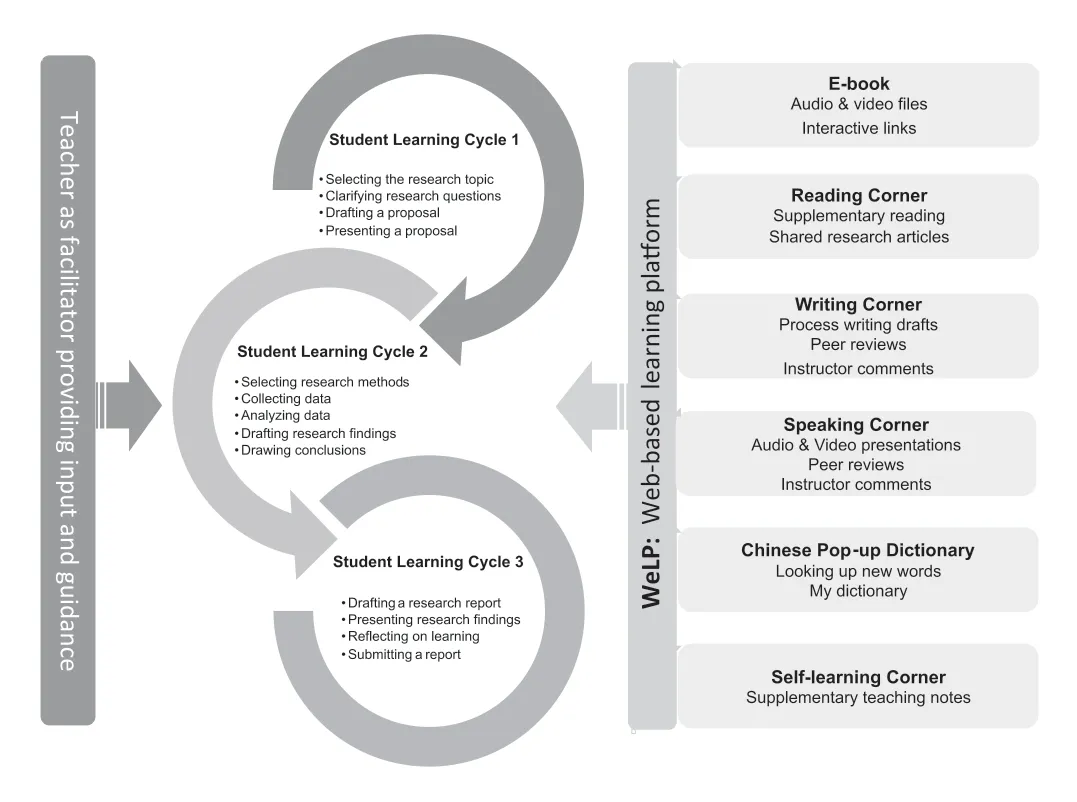
Figure 2 Integration of PBLL & TELL in a Chinese Communication Course
III. Research Questions and Methodology
The construction of WeLP was completed in January 2018, and the advanced Chinese communication course was restructured based on an integrated PBLL and TELL approach which allowed students access to engaging materials and resources anytime in a webbased environment. The PBLL and TELL integrated course was officially implemented in February 2018.
The purpose of this study was to evaluate the learning effectiveness of WeLP on students of an advanced Chinese communication course (LANG1127, Chinese for Non-Chinese Language Background Students VIII).There were three research questions:
a. How is the web-based learning platform conducive to student learning?
b. Which functions are useful to the students and why?
c. To what extent are students satisfied with the webbased learning platform and where improvement should be made?
This study employed a mixed approach for “collecting,analyzing and interpreting quantitative and qualitative data in a single study” (Onwuegbuzie & Leech,2006). Both quantitative and qualitative instruments were adopted to investigate the overall usefulness of the six featured components of the web-based learning platform, the reasons behind the usefulness or otherwise, the extent of user satisfaction and the areas for improvement. In the investigation, surveys, focus group interviews and document analysis were used to collect data and to do triangulation.
A total number of eleven students who were enrolled in LANG1127 in Spring Semester 2018 were asked to complete an online questionnaire generated by WeLP in class, and the response rate was 100%. Although the population size was small, the students did represent a typical spread in terms of their cultural backgrounds and proficiency levels. Table 1 shows the composition of this cohort.
All the eleven students were invited to participate in a focus-group interview. All of them accepted the invitation, and three focus groups were formed. Semistructured questions were used to encourage the free exchange of ideas. To ensure impartiality, a research assistant who was not involved in the teaching of the course led the focus groups, and the interviews were recorded with the participants’ permission. For the purpose of triangulation, the reflective comments written by the students in the last class of the semester were used as a source for documentary analysis. In their reflections, students had been asked to reflect on the entire learning process and product, the acquisition of new knowledge, and the achievement of linguistic and non-linguistic goals they set at the beginning of the project, as well as on the usefulness of the webbased learning platform.
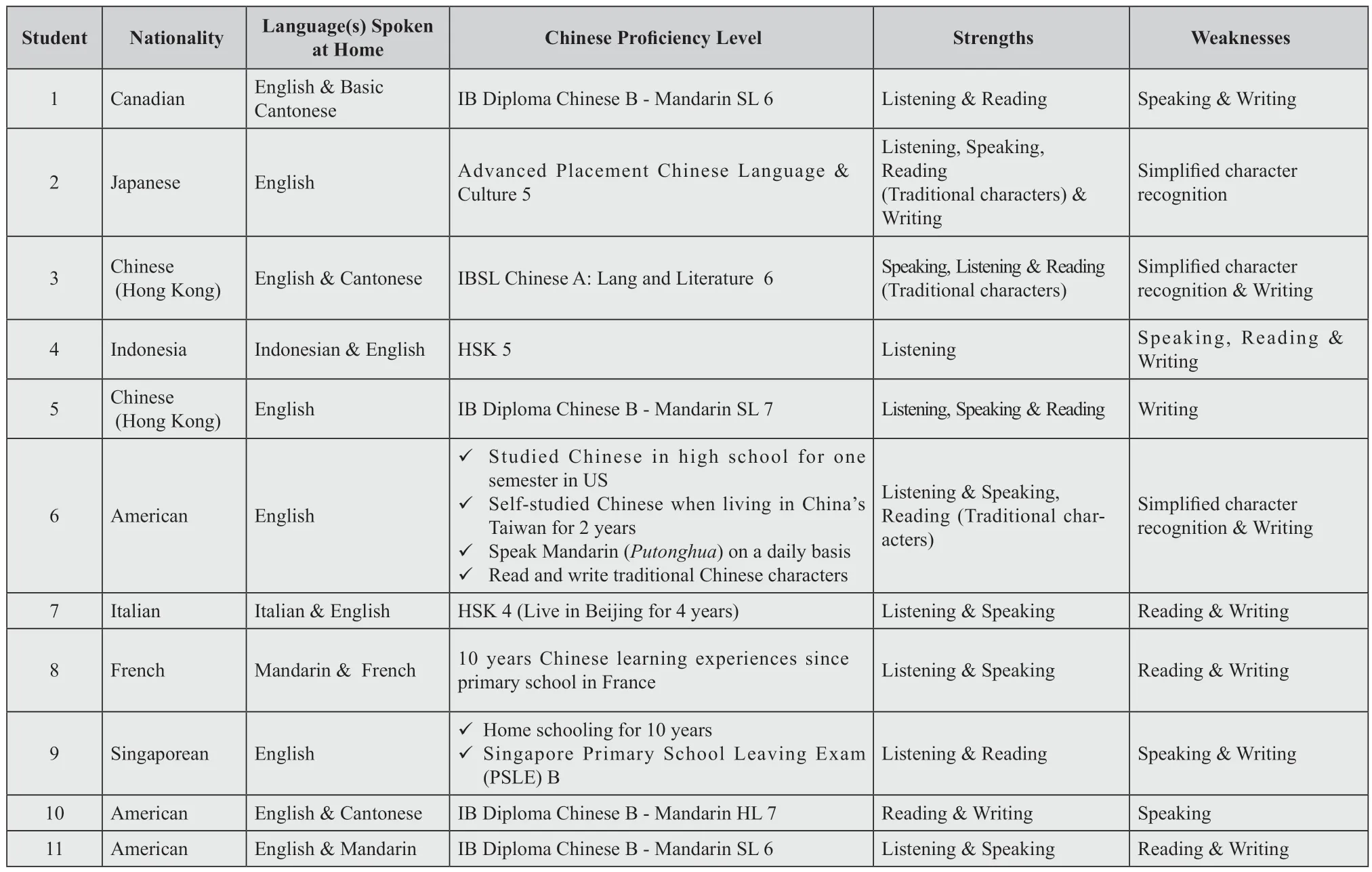
Table 1 Student Profiles
IV. Results
The following results are generated from the data collected in the questionnaire survey, focus groups and students’ reflection. The first part of the questionnaire consists of 6 questions which evaluated the usefulness of all the features in a 3-point Likert scale (3=Useful;2=Neutral; 1=Not useful). The second part consists of 9 questions which assessed their satisfaction and overall experience with the platform on a 5-point Likert scale(5=Strongly agree; 1=Strongly disagree). Students were also encouraged to provide additional comments on specific aspects of the course.
4.1 Effect of the Web-based Learning Platform(WeLP) on Student Learning
This part mainly addresses the first two research questions (a. How is the web-based learning platform conducive to student learning? b. Which functions are useful to the students and why?) through data collected via a questionnaire, focus group interviews and students’ study reflections.
The questionnaire was intended to collect general feedback regarding the six featured components of the web-based learning platform (E-book, Reading Corner, Writing Corner, Speaking Corner, Chinese Pop-up Dictionary, and Self-learning Corner), while the focus group interviews were tasked with collecting explanations on why some functions were considered useful or otherwise.
The questionnaire findings showed that students in general found WeLP useful in helping them learn Chinese. According to the data collected, the Chinese Pop-up Dictionary and the Writing Corner were found to be the most useful, with the highest mean scores (M=2.91) among the six featured components,followed by the E-book, the Self-learning Corner,the Reading Corner and the Speaking Corner, with the Speaking Corner considered the least useful with a lowest mean score (M=2.55) and most polarized opinion (SD=0.656).
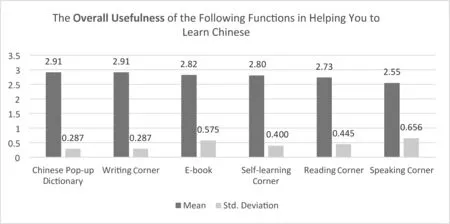
Figure 3 Overall Usefulness of the Featured Components of WeLP
Students were asked to evaluate the learning effectiveness of the six featured components and to rate the usefulness of the specific functions of each featured component.
(1) Chinese Pop-up Dictionary
Both questionnaire data and interview data revealed that the students found the Chinese Pop-up Dictionary very useful. Figure 4 shows that the function of “Looking up new words” received an almost unanimous positive vote from the students (M=2.91; SD=0.287). The function of “Accumulating vocabulary” also added great value to their vocabulary building.
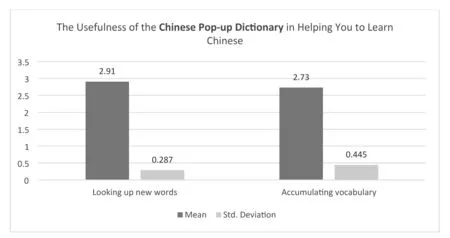
Figure 4 Usefulness of the Chinese Pop-up Dictionary
Why was the Chinese Pop-up Dictionary highly commented by the students? The results of the interview and student reflections provided two main reasons: Firstly, it is very convenient and user-friendly;secondly, it gives corresponding English meaning.Students said the Chinese Pop-up Dictionary was userfriendly because when they just moved the cursor to the word to look up its pinyin, its Chinese meaning and the corresponding English meaning would pop up, and there was no need to use Google or Baidu translation. In one student’s reflection, he stated how this WeLP feature helped him overcome the fear of reading Chinese, “Before taking LANG1127, I am afraid of reading Chinese because I am afraid that there are characters I can’t recognize, but the Chinese Pop-up Dictionary makes me read more proactively. If there are characters which I can’t recognize, I will use the Chinese Pop-up Dictionary. It’s very convenient.”Another student mentioned why she found the Dictionary useful and she spoke of the ease of being able to access the English meaning of a word, “The things we wanted to express are very specific during the process of writing the report. If I use a Chinese dictionary, when I cannot fully understand the Chinese interpretation or I am unsure of how to use it, I will not put it into my writing. Therefore, I am more comfortable referring to the English meaning.”
(2) Writing Corner
According to the results of the questionnaire, the Writing Corner was also generally regarded as a very useful feature, and most of its functions were well received by the students. The function of “Teacher feedback” received a unanimous positive reply from students, with all responses marked “useful” (M=3.00;SD=0.000). Most of the other functions, which were related to draft revision and access to others’ writings(both groupmates’ and other groups’), were also welcomed by the students with only one “neutral”response (M=2.91; SD=0.287). Among all the functions of the Writing Corner, the function of“Peer feedback”received a relatively lower score.
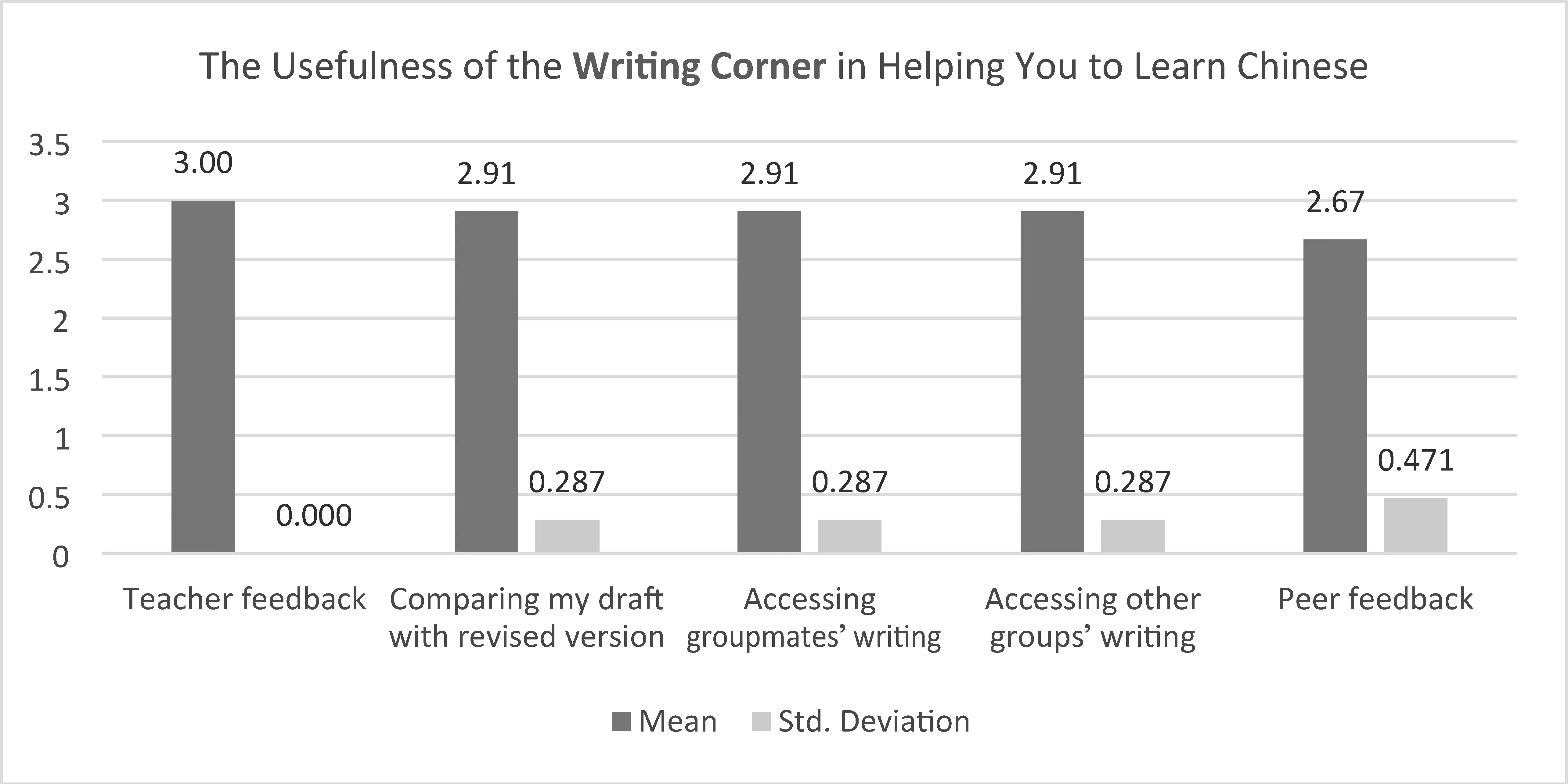
Figure 5 Usefulness of the Writing Corner
The interview data and student reflections indicated that students found the Writing Corner helpful because it provided useful feedback and references.The students welcomed and valued teacher’s feedback,in particular feedback on their writing assignments,which helped them to improve their writing. One student mentioned in her reflection that “From teacher’s feedback, I learned how to use Chinese to express my complex thinking accurately”, and another wrote, “After I get the feedback, I will write down all the errors and avoid the errors in the future.” Students also liked having access to their classmates’ work. Ten out of eleven students said the access to other students’writings could provide them with a reference for their own writing. They referred to reference features like paragraph arrangement, sentence structure and diction.By referring to each other’s work, students admitted that they learned how to use words and sentences that they could not use before. For example, a student said,“Because sometimes I didn’t know how to express myself appropriately and I am not sure which sentence structure is the best, I went to the Writing Corner to see what others say. Then I would know how to write.”While students found reading their peers’ writings useful, none of them mentioned how providing “peer feedback” had helped them in their learning journey in the focus group interviews. Since providing “peer feedback” was not a required part of the course, most students would rather spend time on their own writing assignments instead of spending time on giving comments on others’ writings.
(3) E-book
The questionnaire results revealed that audios and videos (M=2.73) were among the most useful functions for students in the E-book; however, they also demonstrated a higher standard deviation (SD=0.617),and raw data showed that there was one response of“not useful”. The function of “Real-time explanation of vocabulary” gained was the highest scoring (M=2.73)with consistently positive rating from the students(SD=0.445). Hence it was the best received function in the E-book. The results for “Automatic checking for online exercises” (M=2.70; SD=0.458) were also similar. Overall speaking, the individual mean scores for different functions on E-book were consistent with its overall usefulness rating (M=2.82; SD=0.575).
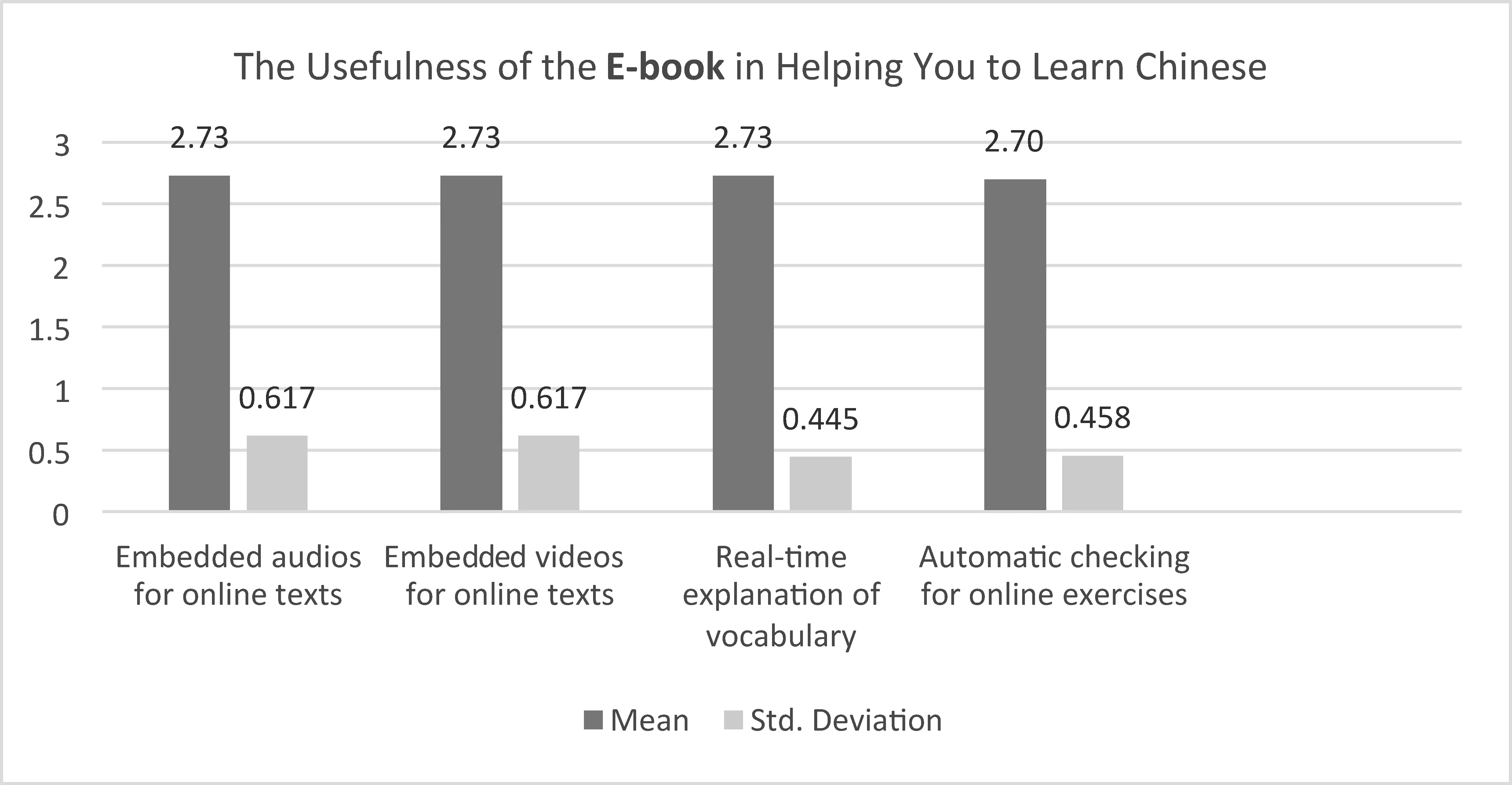
Figure 6 Usefulness of the E-book
During the focus group interviews, students commented the E-book for giving them interactive learning experiences. They specifically pointed out the function of “Embedded audios for online texts”and stated that this function improved not only their ability to recognize Chinese characters and words, but also their listening abilities. One student of Cantonese background reported that the audios had helped him with pronunciation and word meaning. Some students also found the function of “Automatic checking for online exercises” useful and said in the group interviews that the real-time online checking function was very helpful. One of them said, “Whenever I finish the online exercises, I can check the answers instantly…After checking I know where the error is, and then I can try it again and again. The traditional textbook doesn’t have this kind of function.” The E-book was commented on two areas: its interactivity and its content. Students stated that the articles in the E-book had helped them in their writing.
(4) Self-learning Corner
Most of the students agreed that the Self-learning Corner was beneficial in helping them to review vocabulary learned in class (M=2.90; SD=0.300).Students agreed that the Corner catered to the diverse needs of the mixed-ability group by providing a place where they could review the vocabulary and learn points and “issues” discussed in class at their own pace.The comments made by the students at the focus group interviews were consistent with the results of the survey. One gratifying remark made by a student was that “We have the dictations in class, so we will use the Self-learning Corner frequently”. “Dictation” is an exercise introduced in class to help students build vocabulary and practice Chinese character writing,and the exercise was not counted as part of student assessment. In other words, some students were motivated enough to practice writing Chinese and they were not just driven by grades. One student in her reflection mentioned that some topics discussed in class had not shown up in the Corner. While her comment was presented as a disappointment, it told us that students reviewed the in-class content out of class time on the Self-learning Corner.
(5) Reading Corner
There were mixed comments on the various functions of the Reading Corner. While students found the functions of “Accumulating reading materials” and“Reading articles uploaded by peers” (M=2.73;SD=0.445) helpful, some students did not consider the functions of “Seeing articles my groupmates read”(M=2.64; SD=0.481) and “Seeing articles other groups read” (M=2.45; SD=0.656) to be useful for their own language learning.
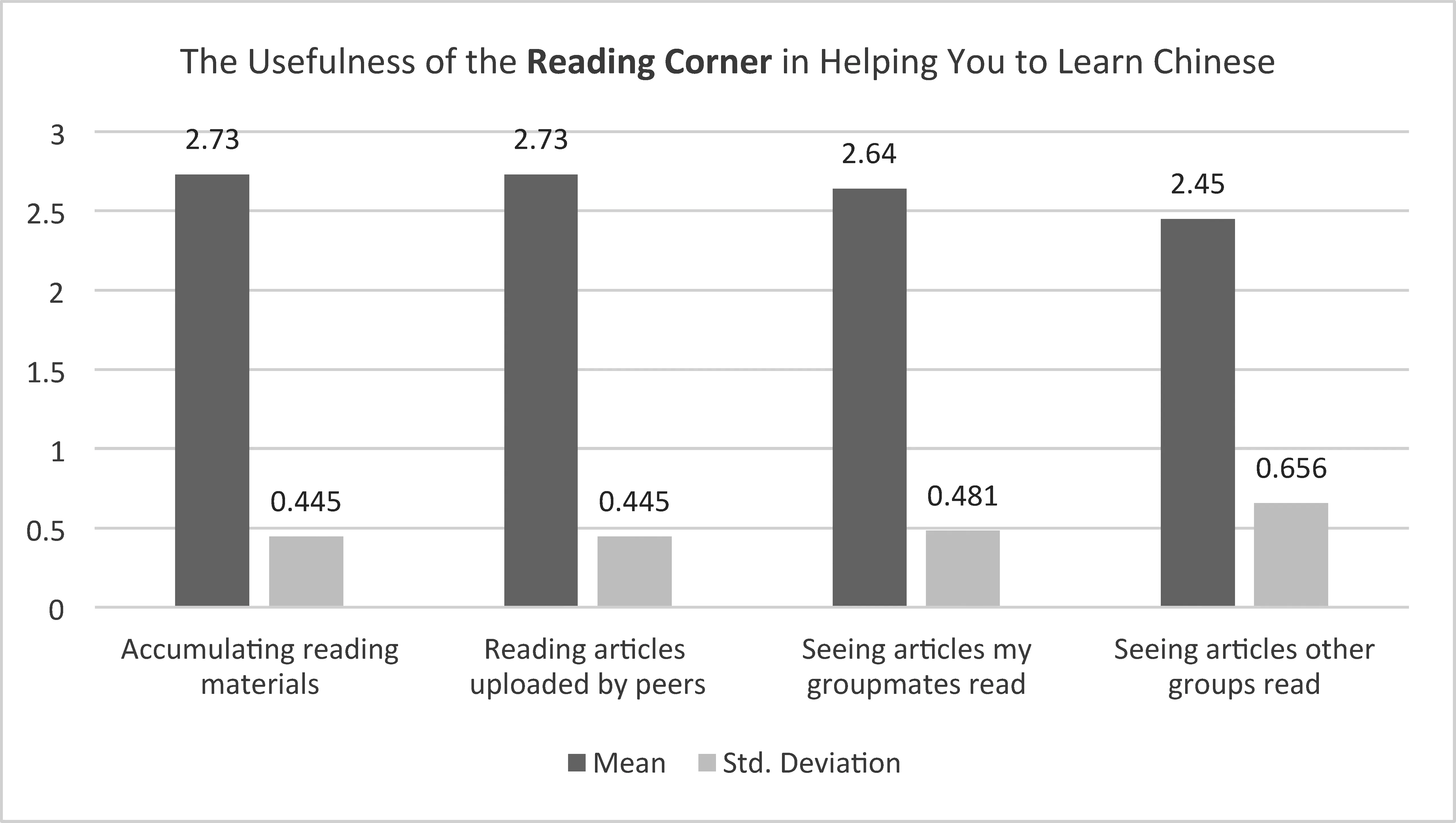
Figure 7 Usefulness of the Reading Corner
The interview data supported the results of the survey.Students used the Reading Corner because they believed that it helped them in their writing. By using WeLP, they were exposed to more reading materials and could read more outside class. They particularly valued the function which enabled them to read the articles uploaded by their peers, so they could refer to the written works done by students of previous cohorts.In the focus group interviews, students claimed that they learned through reading others’ works. One student said, “I don’t think we can copy from others,but after reading others’ articles, we can think about what we can learn from the articles.” When asked if they minded when their peers learned from their writing, all said, “Don’t mind because we can learn from each other.” However, students were not keen to find out what articles other group members read because the reading materials might not have direct relevance to their own project.
(6) Speaking Corner
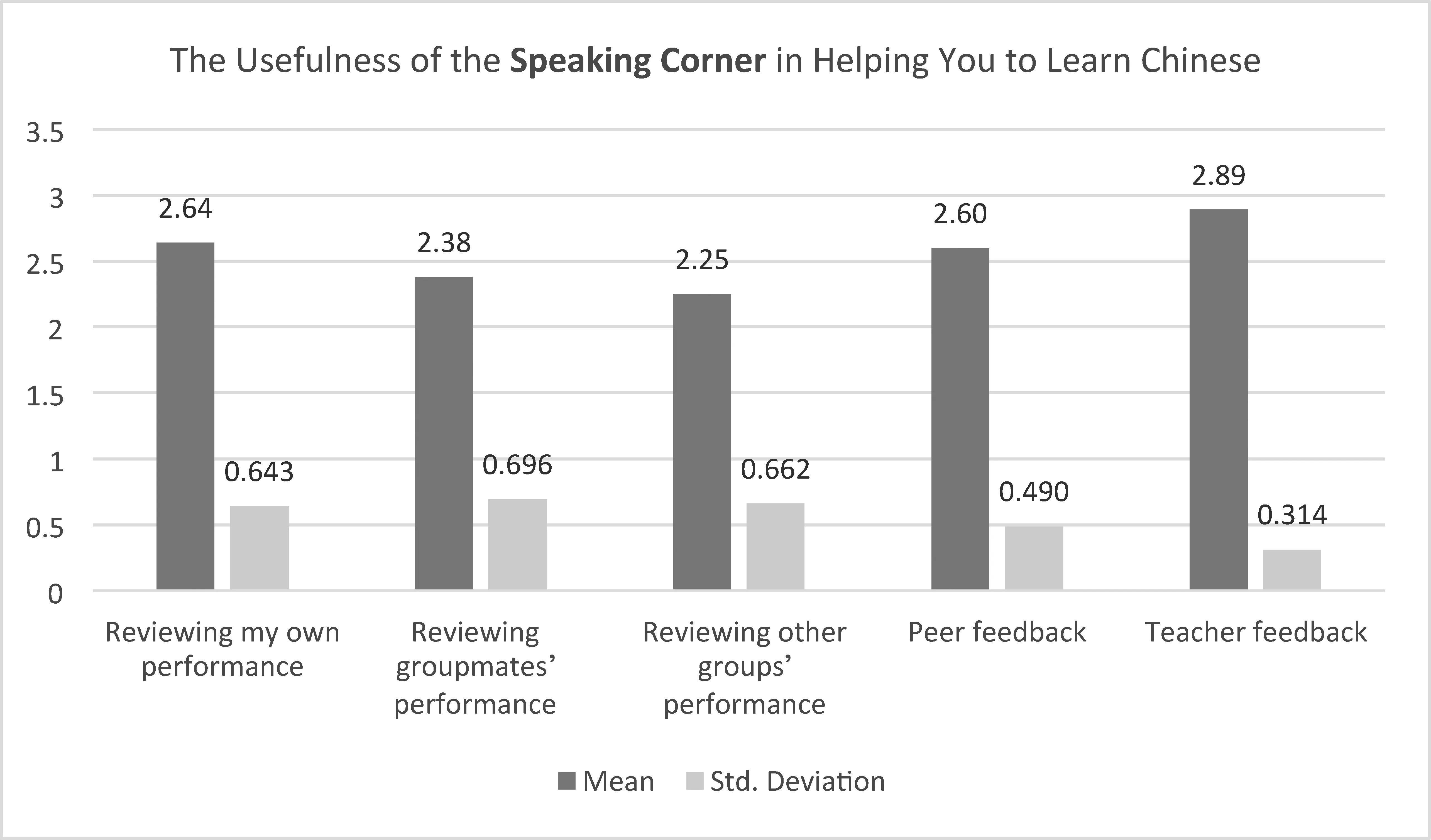
Figure 8 Usefulness of the Speaking Corner
The Speaking Corner was considered less useful than the other features in the platform. Mixed reviews were received on the usefulness of the specific functions.Students were most satisfied with the feedback from teachers (M=2.89; SD=0.314). But the rating on peer feedback was comparatively lower (M=2.60;SD=0.490). Reportedly, less than half of the students(n=5) used the Speaking Corner for peer feedback.Students showed reservation about the effectiveness of reviewing each other’s work. While they found reviewing their own performance relatively useful(M=2.64; SD=0.643), they saw little use in reviewing their groupmates’ performance (M=2.38; SD=0.696)and the performance of other groups (M=2.25;SD=0.662).The interview data, student reflections and questionnaire data were basically consistent, and partially explained the results of the questionnaire.The data showed that students were more concerned about their oral expression and the teacher’s feedback on their own performance. They reckoned listening to other students’ oral recordings was “weird” and was not useful for their learning. Furthermore, while students liked watching the videos of previous students’oral reports, they were reluctant to spend time in watching the videos of their own group members or other groups. In their reflective comments, students attributed their improvement of speaking skills on the practices provided in the entire research process. While they did not want to spend time on their peers’ taped presentations, they admitted spending time watching their own presentations could help them improve.
4.2. Overall User-satisfaction Levels and Areas for Improvement
This part responds to the third research question: To what extent are students satisfied with the web-based learning platform and where improvement should be made?
When invited to give an overall evaluation of their experience of using the web-based learning platform,most students agreed that they were engaged in learning Chinese through the platform (M=4.27; SD=0.617),and generally enjoyed using it (M=4.00; SD=0.853).Students did utilize the platform outside class time to engage in learning, as they commonly used it for revision (M=3.82; SD=0.833), and more than just for submitting assignment (M=2.64; SD=1.367). However,it was noted that the standard deviation for both statements was high, indicating that students’ habit and frequency of using the platform outside the classroom differed. The same was also observed about “The WeLP is easy to navigate”. It was given a generally modest mean score (M=3.64) but very divided views among the students (SD=1.068).
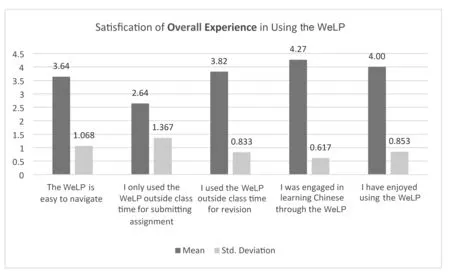
Figure 9 User Experience: Overall Satisfaction
The interview data and student reflections provided a further explanation for the results of the survey.
On student engagement in Chinese learning through the WeLP, the interview data showed that students agreed that they had always used the WeLP to learn Chinese out of class based on their interests and needs.One student said at the interview that “Comparing with traditional textbooks, (the WeLP) makes our learning more independent; I can learn based on my interests. In this way I learn Chinese very hard this semester”. In the reflections, five students mentioned that the learning materials uploaded onto WeLP were abundant, so they could practice Chinese and engaged in language activities anytime anywhere. They repeated the comment that the Corners on WeLP were very useful because the platform had enabled them to learn Chinese outside class at their own pace. One student wrote in the reflection that “I think that the learning Corners can enhance my Chinese learning. When I write my research paper, I use writing corner to learn the expressions and the usage of formal language. The online exercises are also very useful”.
Various reasons were given for why students found the learning experience engaging and enjoyable. One reason was that it was interactive. Another reason was the efficiency it offered. For example, all students liked the Chinese Pop-up Dictionary because it made learning Chinese more efficient and enjoyable. “I really like the Chinese Pop-up Dictionary. It can make us get the meaning of any new word very quickly,” one student remarked.
While the overall user satisfaction level was high, the WeLP learning experience was by no means troublefree. First, not everyone made full use of the platform.For example, in the focus group meetings, two students admitted that they mostly used the platform to submit assignments and that they had no time to read the other materials on WeLP. Second, one comment alerted us to the provision of wrong answers for some homework assignments. Third, three negative comments were recorded in the additional feedback section at the end of the questionnaire. All three respondents complained about the navigation problem of the platform. Their comments are presented in the table below.
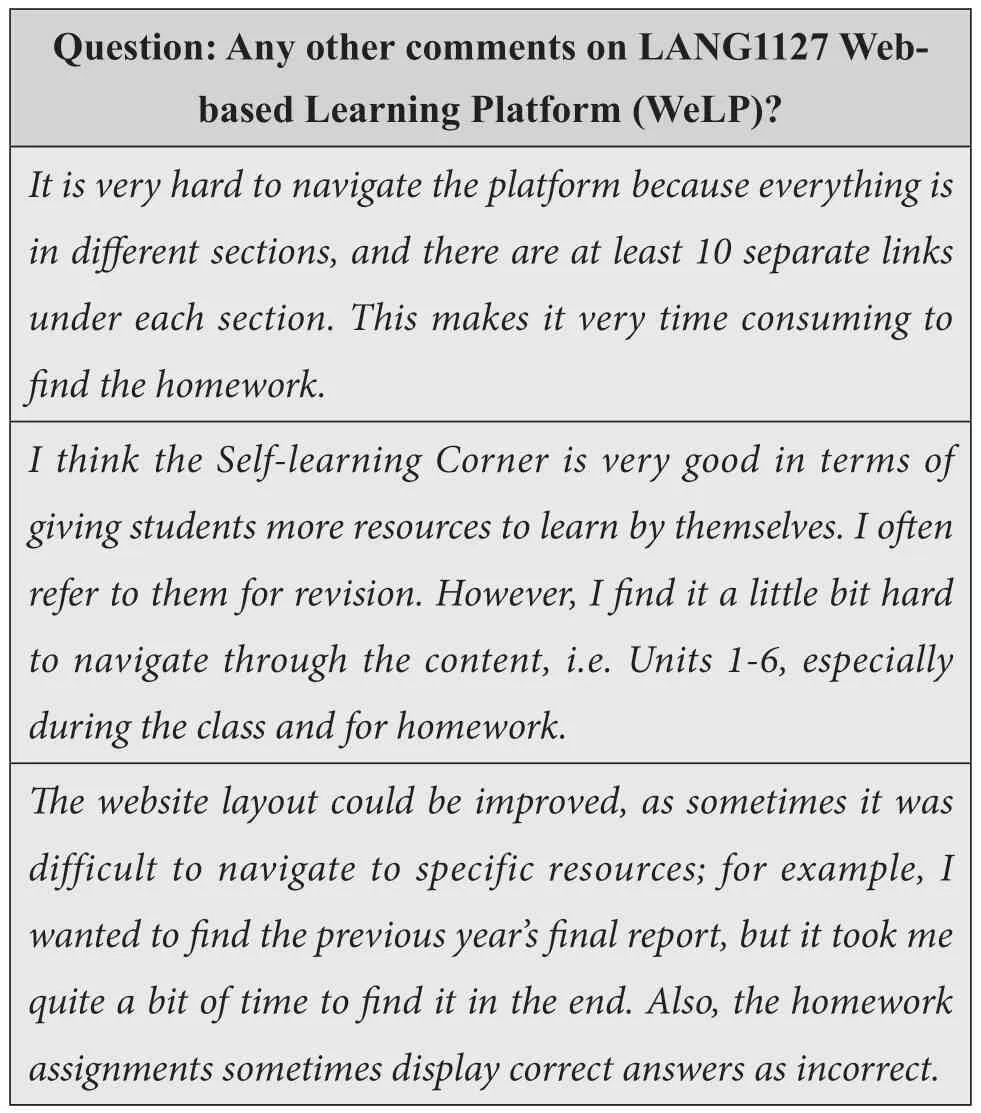
Table 2 Students’ Comments on LANG1127 Web-based Learning Platform
In students’ reflections, a few of them also mentioned that the navigation was not easy—“sometimes it is hard to find the activity or example that the teacher was talking about” and “it is time consuming to find assignment”. At the focus group meetings, some students even proposed solutions, such as setting up a“search bar” or highlighting the learning process on the platform in bold colors.
V. Discussion
The research findings show that the majority of WeLP’s featured components have been useful to students’learning. A close examination of the quantitative and qualitative data reveals that the integration of technology to the advanced Chinese communication course with a PBLL pedagogical approach has enhanced the students’ learning experiences. The reported benefits are summarized as follows.
(1) Technology helps to tailor learning experiences to individual learners’ needs.
The students of the course came from diverse backgrounds and their Chinese learning abilities and learning needs varied. While all of them had a reasonable level of listening and speaking proficiency,some had problems with Chinese character recognition and writing. A few of them might be proficient Cantonese speakers but they could only read Chinese characters in the traditional form. Hence, useful and efficient tools were crucial in their vocabulary acquisition, in helping them improve their reading and writing competence, especially when they read authentic materials related to their research topics and wrote their own group research papers out of class. The online functions provided all the tools,and the students could easily tailor their learning experiences according to their individual needs. The popularity of the Chinese Pop-up Dictionary and the embedded audios and videos for online texts proved that technology had helped students to construct their own learning experiences. This perhaps is the support and resource that students do not get in a classroom environment because it is impossible for teachers to provide timely support to everyone all the time.
(2) Technology increases the accessibility of learning materials and expands the scope of learning.
WeLP was considered by the users to have released the time and space constraints inherent in a classroom delivery (Liang & Lam, 2017). Students of this cohort reported that they had been exposed to many resources, such as E-book, articles uploaded by teachers, presentations and writings done by their peers and previous cohorts. WeLP has opened up a wealth of learning materials that they could use in and out of class. While conducting their projects, many of them admitted that they had referred to previous samples or groupmates’ and classmates’ works and found them very useful. The multiple functions of WeLP provided the students with access to other students’ writings in the Writing Corner, online language exercises and auto-checking in the E-book,supplementary vocabulary revision in the Self-learning Corner, reading materials accumulated by themselves and uploaded by peers, and presentation videos. The increased accessibility of materials online has resulted in students’ learning experiences being expanded.
(3) Technology enables the provision of timely feedback and sustains student motivation.
Students value teachers’ feedback. Timely feedback is very important for students’ learning and it can also act as a strong motivator to sustain student interest. In the TELL-PBLL course, the final product to be submitted by the students was a research paper. Throughout the semester, they learned to write the different parts of a research paper while conducting their research,including research topic, background, research method, design of data collecting tool (interview questions, documents, questionnaire, observation plan), research findings and conclusion. Some students said they were encouraged to revise the same writing assignment more than once after they had received prompt feedback from their teacher, usually within two days. Besides the Writing Corner, they also stated that the Pop-up Dictionary and the auto-online checking in the E-book had also sustained and motivated them in their learning journey. On the other hand, WeLP had allowed the class-teacher to better understand the learners through reading their works and responding to their questions, so the teacher was in a better position to provide appropriate guidance in a timely manner.
(4) Technology encourages autonomous learning and collaborative learning.
The research findings revealed that students were using language resources and the learning tools to do self-directed learning in groups and individually. For example, the special function of the Writing Corner,displaying the different versions of all students’assignments, helped users in their autonomous learning. With this technological support, students said they had learned how to use words and sentence structures accurately and appropriately to express complex ideas. Using the auto-online checking tool,students could repeat language exercises many times until they mastered the language points. In the Selflearning Corner, students enhanced their Chinese ability not only through their own project but also through reviewing the vocabulary, learning points and “issues” discussed in class with other groups. The Chinese Pop-up Dictionary was also a very useful tool to help students improve their reading and writing by themselves. With all the technological support,students were supported and encouraged in their autonomous learning.
WeLP also provides a learning platform which facilitates collaborative learning. Most students mentioned that they had learned from each other through taking reference of their groupmates’ and classmates’ works. The Writing Corner enabled students to collaborate in different ways throughout the semester. Since they could easily access their peers’ writing, they could work as a group in an efficient manner. They could check the progress of their group project, what their groupmates had done, and in what way they could contribute to the completion of the project. For example, a group member drafted and uploaded a questionnaire, other members would comment, revise and upload an edited version. Similarly, students also reported that they had got together in the Speaking Corner to watch the presentation rehearsal videos uploaded by their group members. They helped each other to improve the group presentation. WeLP managed to transcend the limitation of time and space and allowed students to collaborate on their projects beyond school hours and settings.
By creating a teaching/learning platform that helps to break the boundaries of time and space, students became motivated, collaborative and autonomous learners. WeLP has succeeded in establishing a prototype of a PBLL-TELL integrated Chinese communication course. It promotes self-directed learning of Chinese at a post-beginner level based on student needs and interests. The flexibility and resourcefulness it offered has helped tremendously in accommodating students of mixed abilities, learning styles and language backgrounds.
VI. Future Direction
While the findings of the present study suggest that students of diverse backgrounds and learning needs have benefited greatly from a project-based curriculum supported by this technology-enhanced language learning platform, they also indicate that the PBLLTELL integration has just begun. WeLP needs further enhancement based on the feedback collected from users, especially on the technical aspects. Navigation needs to be improved and other technical issues like a low speed of the server, wrong answers popping up on some online exercises, etc., also require immediate attention.
One limitation of this study is the small population size.The study is based on one cohort of eleven students who represented a typical profile of the LANG1127 class. Future cohorts of LANG1127 students will also be invited to comment on the effectiveness of the learning platform. Furthermore, WeLP can be modified to suit the needs of students in other language classes with a different teaching and learning environment. It is hoped that future collaboration with other language teachers within and outside our institution will provide a further incentive for the enhancement of this technology-enhanced language learning platform.
About the Authors
Dr. Liang Xin is a senior lecturer at the Center for Language Education, School of Humanities and Social Science at Hong Kong University of Science and Technology. Her research interests include Chinese teaching methodology and pedagogy,Chinese curriculum design, and teacher education.
Dr. Martha Lam is an Associate Director at the Center for Language Education, School of Humanities and Social Science at Hong Kong University of Science and Technology. Her research interests include second language teaching and learning, teacher education, and use of bilingual skills.

